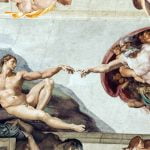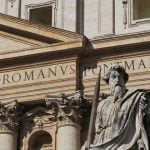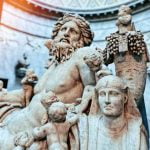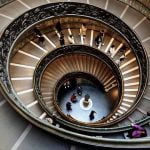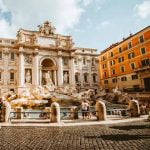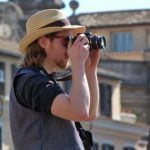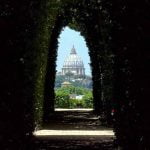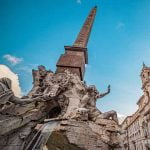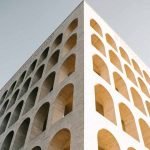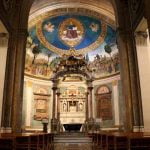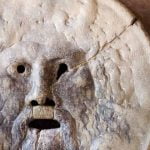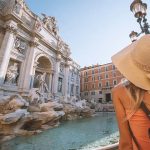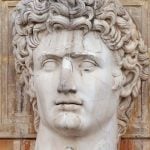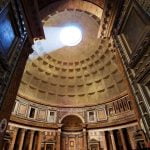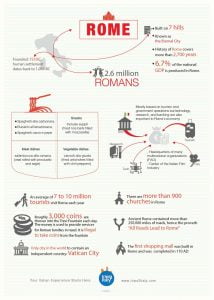 Known as the cradle of civility, a city that influenced the fate of many populations for centuries, Rome is a place of a thousand faces. From a cultural point of view, Rome is probably the richest city in the world. Blending its ancient past with the contemporaneity in a unique way, Rome creates a unity between decades and tells the story of the evolution of humanity.
Known as the cradle of civility, a city that influenced the fate of many populations for centuries, Rome is a place of a thousand faces. From a cultural point of view, Rome is probably the richest city in the world. Blending its ancient past with the contemporaneity in a unique way, Rome creates a unity between decades and tells the story of the evolution of humanity.
The cultural heritage enclosed in such a contained space is immense, including archaeology, art, architecture, literature and music.
Today, Rome is the political capital of Italy, but also the center of Christianity. As such, it is easy to say that Rome still influences the fates of many. The state of Vatican is a world apart, a city within a city built through the stratification of numerous architectonic styles.
Now, the capital uses every modern resource to reach the people, and one of those resources is television. The relationship between Rome and cinema has always been thrilling. In fact, the city hosts one of the most important movie studios in Italy and Europe, Cinecittà. Attracting dozens of local and international actors and TV personalities, Rome also boasts the headquarters of the national television, RAI.
Trying to discover all these multiple personalities of Rome would require years. Nonetheless, the capital opens itself to everyone and shares a story about rising and falling, about touching the bottom to then resurrecting like a phoenix, ready to change the world once again.
Rome’s Art and Architecture
The oldest model of architecture in Rome is part of the Etruscan-Italic style characterized by a different type of temple compared to the Greek model. In fact, the Etruscan temples were oriented on a higher podium and had wooden roofs covered with polychrome terracotta tiles and decorated with statues. There are only a few remains left of these majestic edifices, such as the Temple of Jupiter Optimus Maximus.
The Roman architecture belonging to the imperial age is probably the most widely documented and also the one that primarily inspired the architecture of many other cities of the Empire. From this era, there are numerous examples of Roman capitols, curie, and basilicas, but also spas, theaters, amphitheaters, and markets.
Probably the most famous example of the architecture of the era is Amphitheater Flavio, also known as the Colosseum.
Other important architectural works of ancient Rome include a system of perfect aqueducts and sewers, public baths, fountains, nymphs, but also monuments of political interest, such as the triumphal arches.
From the Republican age, it is worth mentioning Domus Aurea, an important complex of buildings with great significance. Another stunning example of the age is the Roman Forum.
Many other public buildings, such as the Roman spas, also changed architecture during this age. Among the most grandiose architectural achievements are the Baths of Diocletian.
Regarding religious architecture, Rome is the place where it is easy to note the smooth transition from complex temples worshiping pagan gods to the first examples of Christian basilicas and baptisteries.
Among the most ancient monuments of Christian Rome, apart from the Basilica of Saint Peter in Vatican City, we have to mention the church of San Giovanni in Laterano. Built between 311 and 314 AD, this is one of the oldest Christian edifices on the territory.
The church was transformed and rebuilt various times along the centuries, but the edifice always kept its original five-nave system with transept that shows how Christian buildings were initially organized. The church was lastly rebuilt by Borromini in the seventeenth century, and it also hosts artistic works of great importance.
The Basilica of Saint Paul is also remarkable, built outside the walls and erected on the apostle’s grave. The basilica was also transformed and embellished for centuries, then destroyed in a fire in 1823. After the fire, the edifice was rebuilt in a manner faithful to the pre-existing construction and it now hosts a ciborium by Arnolfo di Cambio from the thirteenth century, a mosaic representing Christ and the saints, work of the Venetian school, in the apse, and many other noteworthy works.
There isn’t much evidence of the original forms of Romanesque basilicas; however, they were undoubtedly a model for the many basilicas that erected in the following centuries. As to the origin of the architectural model, which obviously didn’t find inspiration in the modest Christian buildings, the most popular opinion among researchers is that of a deviation from the great imperial buildings but interpreted in an original way and tailored to the particular needs of a place of worship.
The architectural vision changed through the time, and in the fifth century another typical example of basilica was used for the construction of the Basilica of Santa Maria Maggiore. Similar to many other religious edifices, the basilica changed its appearance with the time and it has been rebuilt and redecorated according to the personal tastes of the various popes. Nevertheless, although its current façade belongs to the eighteenth century, the basilica maintains the original architectural structure with three naves divided by columnar architraves.
The church is largely decorated with mosaics and it preserves part of the original decorations from the fifth century.
One of the most important early Christian creations in Rome is the Basilica of Santa Sabina that still retains part of its original physiognomy of a church with three naves. Its importance, however, is due to the importance of the luminary factor compared to the traditional Romanesque structural style. The doors of the basilica, a very rare example of early Christian sculpture in wood, are also important.
Due to the troubled events Rome faced between the sixth and the seventh centuries, the artistic activity partially declined during this period. The early Christian tradition, however, remained sensitive to the Byzantine influences due to the political and cultural ties with the east.
Of a great importance from this period, from both an artistic and architectural point of view, is the church of Santa Maria Antiqua, founded in the sixth century on a previous construction on the Palatine hill. The church has three naves and a presbytery, and it preserves a sort of pictorial evolution consisting of five cycles of frescoes, among which the most remarkable are those in the chapel of Teodoto depcting Saint Quirico and Giulitta.
A distinguished period in the art and architecture of Rome is the one between the twelfth and the thirteenth centurieswhen many refined decorations for some of the early Christian edifices were created. To this period belong the masterpieces in the cloister of the church of San Giovanni in Laterano, but also the reconstruction of the church of Santa Maria in Trastevere.
The painting of these centuries appears to be largely tied to the assimilation of the Byzantine style, but it reveals a remarkable vitality and a superior ability to transmit emotions. Some beautiful examples of the style are found in the frescoes in the convent of Santa Cecilia, but also the Coronation of Mary and the mosaics in the apse of Santa Maria in Trastevere.
All these examples marked the vigorous individuality of Rome away from the Byzantine mannerism, concluding with the recovery of the space, dimension, and volume of the bodies, in parallel with the revolution carried out by Giotto.
Between the end of the thirteenth century and the beginning of the fourteenth, it is also worth mentioning the presence of Arnolfo di Cambio, a Gothic sculptor whose works decorate the church of Saint Paul and Santa Cecilia, as well as Santa Maria Maggiore.
The fifteenth century enriched the city with considerable Renaissance monuments thanks to the affluence of numerous artists. A classic example is Palazzo Farnese, but also the interesting church of Santa Maria della Pace.
An important example of frescoes by Raphael are located inside the church of Santa Maria del Popolo, while many other churches are decorated with works belonging to Bernini and Caravaggio, such as the Conversion in the Basilicaof Saint Paul and the Crucifixion in the Basilica of Saint Peter.
Some of the most beautiful public buildings of Rome also owe their luxurious nature to this period. Among them, are noteworthy Palazzo Madama and Palazzo Farnese.
Towards the middle of the sixteenth century, a man settled in Rome and became the undisputed ruler of the artistic life of the city, Michelangelo. With vast artistic skills in both painting and sculpture, Michelangelo changed the face of the city. One of its most renowned examples is the Universal Judgment in the Sistine Chapel.
For the Baroque era, a building worth mentioning is Quirinal Palace, where remarkable art collections are preserved, including a vast series of frescoes.
The greatest representatives of the Roman Baroque style were Bernini and Borromini. The first one carried out an intense period of activity as a sculptor, realizing numerous fountains and funerary monuments, and the planning of Piazza Navona. Borromini expressed a more dramatic Baroque style visible in the church of Sant'Ivo alla Sapienza.
Splendid examples of art from the eighteenth century are the staircase of Trinità dei Monti by Alessandro Specchi and the Trevi Fountain by Nicola Salvi.
From the nineteenth century, a few noteworthy edifices are the monumental Palace of Justice and the famous monument of Vittorio Emanuele. The fascist period also contributed to the architecture of the city through monumental buildings such as the Eur and the Foro Italico.
Among the most noteworthy achievements of the postwar period are the Termini Station, Flaminio Stadium and Palazzo dello Sport.
Science in Rome
As it is easy to imagine, Rome not only shaped the world from the most ancient times, it also gave it important scientists. Either born in Rome or simply formed in the city, many beautiful minds have their pasts linked to the capital.
Among them, Enrico Fermi, a physicist considered the architect of the nuclear era.
Fermi was born in Rome, the city where he became chairman of Theoretical Physics at the University of Sapienza. Here, one of his most important experiments took place, which led to the discovery of the role of the neutron slowdown in nuclear energy.
Subsequently, Fermi conducted further research and built the first nuclear fission reactor, producing the first chain-controlled nuclear reaction. He was also one of the technical directors of the Manhattan Project and contributed to the realization of the atomic bomb.
In 1938, Fermi was awarded the Nobel Prize for identifying new elements of radioactivity and the discovery of the nuclear reactions.
Literature in Rome
Literature, as arts and architecture, left its heritage in Rome and influenced not only Italy, but the whole world.
Among the many important writers born in Rome, the most famous is probably Alberto Moravia. One of his most important works is La Ciociara, a romance describing the desperate situation in Italy towards the end of the Second World War.
Many of his other works are also related to the city of Rome, Racconti Romani being another one of his most famous books.
Elsa Morante is another important poet and writer born in Rome. Morante is known for numerous masterpieces, such as L’isola di Arturo and La Storia, and she is one of the most renowned Italian female writers from the postwar period.
Moravia and Morante shared a romance and were married for over 20 years.
Other literates worth mentioning are Ida Magli, an influential thinker and philosopher, but also the author of numerous relevant essays, and Julius Evola, a multi-faceted character considered a poet, painter, and writer.
Music in Rome
Music has also played an important role in the culture of Rome. The capital gave the world numerous talented singers, composers, and orchestra directors. One of the most noteworthy is Ennio Morricone, a musician, composer and orchestra director who won an Oscar for the incredible soundtracks of the cult movies from the 90s.
Claudio Villa is a renowned musician and one of the most outstanding opera voices in Italy. His music sells worldwide and he won the Festival of Sanremo four times.
Antonello Venditti and Claudio Baglioni are two eclectic roman songwriters and singers who were able to captivate the hearts of the Italians with their incomparable styles. We also have to mention Renato Zero, another famous artist.
Last but not least, an icon of the Italian music famous all over the world is Eros Ramazzotti.
Movies and Cinema in Rome
Boasting one of the largest cinema studios in Europe, Rome has a well-established movie and cinema culture. Moreover, the capital was featured in numerous international movies thanks to its beauty and ancient charm.
Some of the most famous international movies filmed in Rome include Ben-Hur, The Way of Dragon, featuring Bruce Lee, Gangs of New York directed by Martin Scorsese, Ocean’s Twelve, Angels and Demons, Eat Pray Love, and To Rome With Love by Woody Allen.
Besides these masterpieces, there are numerous Italian movies that were filmed in the capital.
Among the most famous roman actors, we can mention Silvana Mangano, one of the most successful Italian actresses, Anna Magnani, winner of an Oscar, and Alberto Sordi, one of the most important actors in the history of Italian cinema.
Even if not from Rome, it is also worth mentioning Marcello Mastroianni who was born in Frosinone, a small province in Lazio. Nevertheless, he is one of the most important Italian actors renowned worldwide. Vittorio De Sica is another charismatic figure born in Frosinone, but he was known as the unofficial “son of Rome.” De Sica won four Oscars and is renowned for his talent all over the world. De Sica’s son, Christian, was born in Rome and, following his father’s footsteps, is one of the most beloved comedy actors in Italy.
Among the directors and filmmakers, perhaps the most important to mention are Sergio Leone, Carlo Verdone, and Roberto Rossellini.
Travel Guides
[wudrelated include="1837"]
Lazio Region of Italy
[wudrelated include="3754"]
Cities in Lazio Italy
[wudrelated include="3752"]
